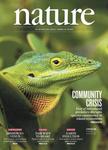-
作者:Tollefson, Jeff
-
作者:Poulain, Melina; Smith, Rory; Duc, Pierre-Alain; Marleau, Francine R.; Habas, Rebecca; Durrell, Patrick R.; Fensch, Jeremy; Lim, Sungsoon; Muller, Oliver; Paudel, Sanjaya; Sanchez-Janssen, Ruben
作者单位:University of Oulu; Universidad Tecnica Federico Santa Maria; Centre National de la Recherche Scientifique (CNRS); Universites de Strasbourg Etablissements Associes; Universite de Strasbourg; University of Innsbruck; Istituto Nazionale Astrofisica (INAF); University System of Ohio; Youngstown State University; Centre National de la Recherche Scientifique (CNRS); Ecole Normale Superieure de Lyon (ENS de LYON); Universite Claude Bernard Lyon 1; Yonsei University; Swiss Federal Institutes of Technology Domain; Ecole Polytechnique Federale de Lausanne; University of Cambridge; University of Cambridge; Yonsei University; University of Edinburgh
摘要:Nuclear star clusters (NSCs) are the densest stellar systems in the Universe. These clusters can be found at the centre of all galaxy types but tend to favour galaxies of intermediate stellar mass around 109M circle dot (refs. 1,2). At present, two main processes are under debate to explain their formation: in situ star formation from gas infall3 and migration and merging of globular clusters (GCs) caused by dynamical friction4. Studies5, 6, 7, 8-9 of NSC stellar populations suggest that the f...
-
作者:Castelvecchi, Davide
-
作者:Klocke, Philip; Howell, Larry L.
作者单位:Brigham Young University
-
作者:Kogevinas, Manolis; Pollarolo, Giulia; Barouki, Robert
作者单位:ISGlobal; Institut National de la Sante et de la Recherche Medicale (Inserm)
-
作者:[Anonymous]
-
作者:Fielden, John; Siegner, Sebastian M.; Gallagher, Danielle N.; Schroder, Markus S.; Dello Stritto, Maria Rosaria; Lam, Simon; Kobel, Lena; Schlapansky, Moritz F.; Jackson, Stephen P.; Cejka, Petr; Jost, Marco; Corn, Jacob E.
作者单位:Swiss Federal Institutes of Technology Domain; ETH Zurich; Universita della Svizzera Italiana; CRUK Cambridge Institute; Cancer Research UK; University of Cambridge; University of Cambridge; University of Cambridge; Harvard University; Harvard Medical School
摘要:The DNA damage response (DDR) is a multifaceted network of pathways that preserves genome stability1,2. Unravelling the complementary interplay between these pathways remains a challenge3,4. Here we used CRISPR interference (CRISPRi) screening to comprehensively map the genetic interactions required for survival during normal human cell homeostasis across all core DDR genes. We captured known interactions and discovered myriad new connections that are available online. We defined the molecular...
-
作者:Cui, Xiekui; Yang, Han; Cai, Charles; Beaman, Cooper; Yang, Xiaoyu; Liu, Hongjiang; Ren, Xingjie; Amador, Zachary; Jones, Ian R.; Keough, Kathleen C.; Zhang, Meng; Fair, Tyler; Abnousi, Armen; Mishra, Shreya; Ye, Zhen; Hu, Ming; Pollen, Alex A.; Pollard, Katherine S.; Shen, Yin
作者单位:University of California System; University of California San Francisco; University of California System; University of California San Francisco; University of California System; University of California San Francisco; UCSF Medical Center; UCSF Helen Diller Family Comprehensive Cancer Center; University of California System; University of California San Francisco; University of California System; University of California San Francisco; University of California System; University of California San Francisco; Cleveland Clinic Foundation; University of California System; University of California San Francisco; University of California System; University of California San Francisco; Chan Zuckerberg Initiative (CZI); University of California System; University of California San Francisco
摘要:Human accelerated regions (HARs) are conserved genomic loci that have experienced rapid nucleotide substitutions following the divergence from chimpanzees1,2. HARs are enriched in candidate regulatory regions near neurodevelopmental genes, suggesting their roles in gene regulation3. However, their target genes and functional contributions to human brain development remain largely uncharacterized. Here we elucidate the cis-regulatory functions of HARs in human and chimpanzee induced pluripotent...
-
作者:Plackett, Benjamin
-
作者:Markowska, Monika; Vonhof, Hubert B.; Groucutt, Huw S.; Breeze, Paul S.; Drake, Nick; Stewart, Mathew; Albert, Richard; Andrieux, Eric; Blinkhorn, James; Boivin, Nicole; Budsky, Alexander; Clark-Wilson, Richard; Fleitmann, Dominik; Gerdes, Axel; Martin, Ashley N.; Martinez-Garcia, Alfredo; Nicholson, Samuel L.; Price, Gilbert J.; Scerri, Eleanor M. L.; Scholz, Denis; Vanwezer, Nils; Weber, Michael; Alsharekh, Abdullah M.; Al Omari, Abdul Aziz; Al-Mufarreh, Yahya S. A.; Al-Jibreen, Faisal; Alqahtani, Mesfer; Al-Shanti, Mahmoud; Zalmout, Iyad; Petraglia, Michael D.; Haug, Gerald H.
作者单位:Max Planck Society; Northumbria University; University of Malta; University of Cologne; University of London; King's College London; Griffith University; Goethe University Frankfurt; Durham University; Max Planck Society; University of Liverpool; Max Planck Society; University of Queensland; Griffith University; University of London; Royal Holloway University London; University of Basel; Leibniz University Hannover; University of Queensland; Johannes Gutenberg University of Mainz; King Saud University; Saudi Geological Survey; Pennsylvania Commonwealth System of Higher Education (PCSHE); University of Pittsburgh; Saudi Geological Survey; University of Michigan System; University of Michigan; Smithsonian Institution; Smithsonian National Museum of Natural History; Swiss Federal Institutes of Technology Domain; ETH Zurich
摘要:The Saharo-Arabian Desert is one of the largest biogeographical barriers on Earth, impeding dispersals between Africa and Eurasia, including movements of past hominins. Recent research suggests that this barrier has been in place since at least 11 million years ago1. In contrast, fossil evidence from the late Miocene epoch and the Pleistocene epoch suggests the episodic presence within the Saharo-Arabian Desert interior of water-dependent fauna (for example, crocodiles, equids, hippopotamids a...
